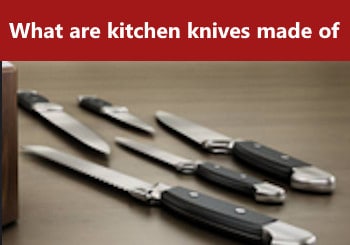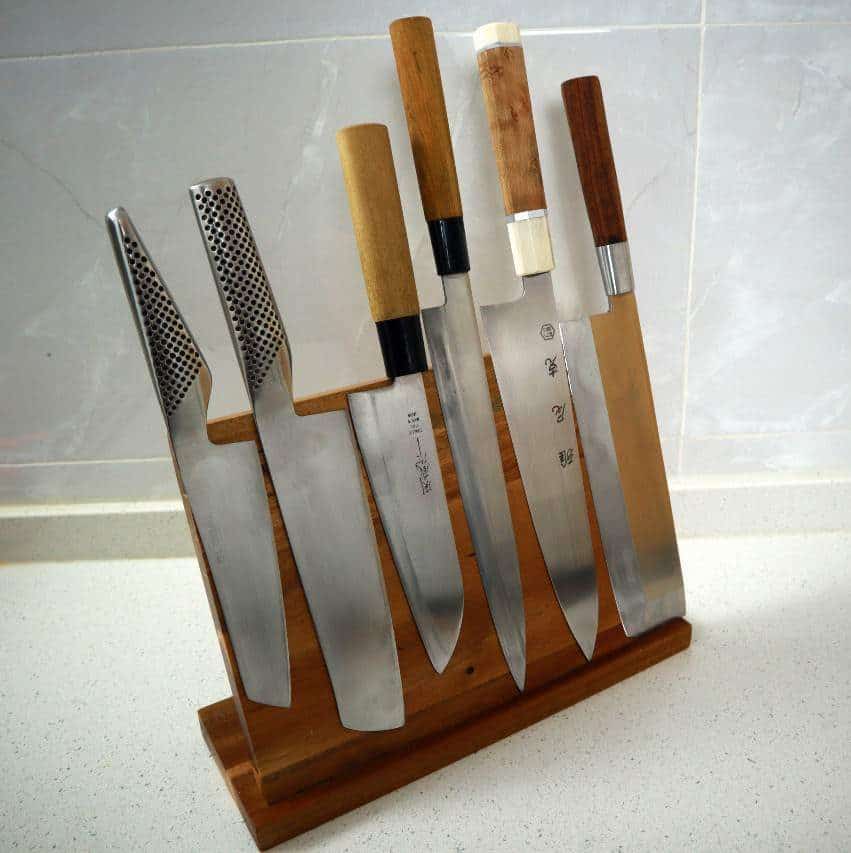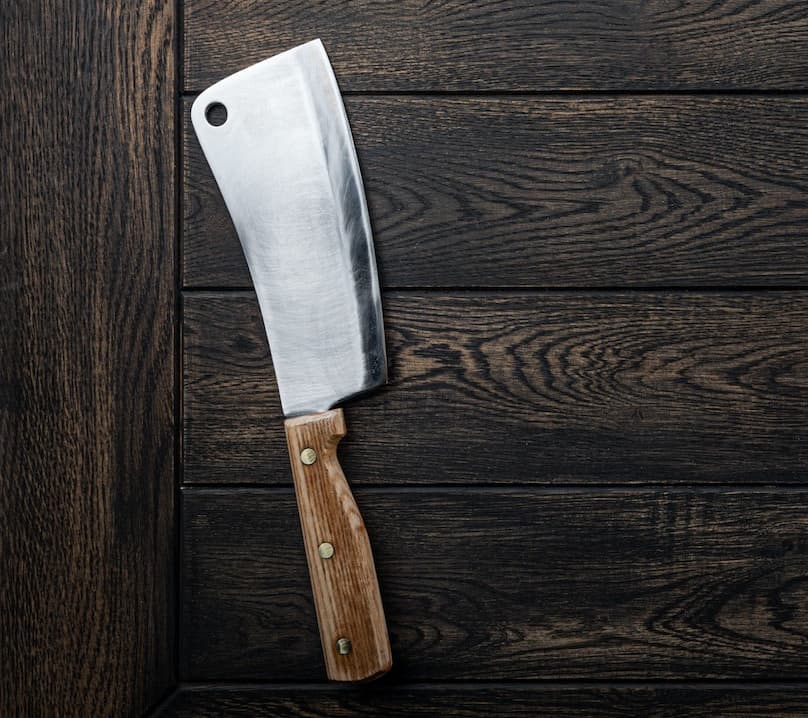What are Kitchen Knives Made Of
| Mini guides to kitchen knives: Kinds of kitchen knives | Materials and construction | Storing | Sharpening | Maintaining sharpness | Rust removal | Disposal | Knife skills | Western or Japanese knives | Main kitchen knife guide |

Kitchen knives are available in a variety of materials, each with its own characteristics and advantages. The user decides which is the best depending on their specific needs and preferences.
The materials are chosen for their unique qualities that enhance the knife’s performance and durability. The selection of materials for the blade should focus on ensuring sharpness, strength, and resistance to wear and corrosion. Manufacturing should also take into consideration easy maintenance for the user.
Further, materials are selected based on their ability to provide a comfortable and secure grip. Aesthetic value may be important, too.
With all these points combined in choosing materials to make kitchen knives, the knives are not only functional and useful, but they are items that the individual manufacturers take pride in their craftsmanship.
So, when choosing a knife or set of knives, it will be important to know what are kitchen knives made of.
What are knives made of?
Knives are most often made of carbon steel, stainless steel, high carbon stainless steel, damascus steel, ceramic, and titanium.
Here is a list of the 6 most common materials used for kitchen knife blades including a description of each material.
- Stainless steel is a popular choice for kitchen knife blades. It is a versatile material that has resistance to corrosion and staining which is easy to maintain and sharpen. Hardness and edge retention vary depending on the type of stainless steel.
- Carbon steel is well known for its excellent sharpness and edge retention. However, this material requires more maintenance and it always needs careful drying after using and washing as it is more sensitive to corrosion and discoloration.
- High carbon stainless steel combines advantages of stainless steel blades with the benefits of higher carbon content. Due to this combination, the blade’s sharpness, edge retention, and ease of sharpening increases which is a good choice for many kitchen knives.
- Damascus steel is not really a type of steel but a layered steel construction. Due to a combination of different types of steel is a unique and visually appealing pattern created on the blade. Part of the various steel alloys are stainless and high carbon steel.
- Ceramic blades are incredibly sharp and they retain their edge for a long time. On the downside, ceramic blades are brittle and can chip or break if subjected to impact or twisting.
- Titanium knives are lightweight and corrosion-resistant, but not as sharp as steel knives. Nevertheless they are still a great choice for certain kitchen tasks.
What is the best steel for kitchen knives?

All depends on your cooking style, personal preferences and how well you maintain knives. Professional chefs often prefer sharpness and edge retention which are both found in high-carbon steel blades. The downside is it requires more care to prevent rust whereas stainless steel is low-maintenance but it may not hold an edge as long.
One sure thing is that a high-quality knife made from any of these materials and properly maintained can last a lifetime. It’s essential to keep your knives sharp at all times and maintain them regularly, whatever the steel type, for the best performance.
What are the best knives for the kitchen?
We have mentioned it already that the best knives for the kitchen depend on the cooking style and personal preferences, but there are a few knives that are indispensable to own when cooking regularly.
- A chef’s knife is a versatile, all-purpose knife to use for chopping, slicing, dicing, and mincing a wide variety of products. Different sizes are available with the most common being around 8 to 10 inches.
- A paring knife has a narrow, pointed blade, and is perfect for small tasks that require precision and control. This little knife is mainly used for peeling, trimming, and coring fruits and vegetables.
- A bread knife is serrated and designed for slicing bread and other products with a hard crust and a softer inside. Because the blade is serrated it is easy to ‘saw’ through the products without crushing it.
- A utility knife is another versatile knife of a size between a chef’s knife and a paring knife. It’s suitable for cutting sandwiches, certain fruits, and other easy to cut ingredients.
Why do some kitchen knives have holes in the blade?
Not all kitchen knives have holes in the blade, but they are functional and we will explain to you how.
- Reduce friction and sticking
The holes, also known as scallops, create air pockets when cutting, reducing the surface area in contact with the food. Less friction means applying less energy when cutting ingredients, which results in easier slicing through ingredients, especially sticky foods such as cheese, moist or starchy ingredients.
- Reduce weight
Having holes obviously reduces the amount of material used for the blade and thus a lighter weight of the knife which makes handling and control of the knife easier.
- Aesthetics
Scalloped knives or granton edge knives look attractive and have a distinctive appearance thanks to the holes in the blade. Personally we don’t find this important but it is popular for those who love unique design elements for their kitchen tools.
- Reduce cost
There are discussions about the amount of material used and the cost. Logically, a knife with lots of holes and less material should be available at a lower price, but note that some brands see this as a design and therefore this is not always reality.
- Storage
It is not always easy to store heavy duty knives safely. Meat cleavers have a hole on the front of the front of the blade specifically for hanging as the more suitable storage mode.

Why do meat cleavers have a hole?
Meat cleavers are essential kitchen knives. They are used for their distinct ability and particular construction to effortlessly cut through animal bones, tough gristly meat, and big hard vegetables.
But have you ever wondered why there is a hole in a meat cleaver? You usually see it at the top of the cleaver in the corner. Take a look at the picture above and you will see what we mean.
Let’s find out 10 reasons why cleavers have holes and what the function of the hole is?
| 10 Reasons | Description (why the hole?) |
|---|---|
| #1 Ideal for Heavy Vegetables | Apart from handling meat, the cleaver is extremely effective for chopping heavy and large vegetables. Its broad and heavy blade can easily split and chop vegetables like squash, pumpkin, and root vegetables with minimal effort, making it a versatile tool in the kitchen. |
| #2 Assist in Blade Release | The hole serves as a grip point for dislodging the blade safely and effortlessly when it gets stuck in dense meat or bone, maintaining efficiency and safety. |
| #3 Enhanced Safety Measures | The hole in the meat cleaver increases safety by reducing blade exposure, thereby minimizing the risk of accidental injuries, especially in bustling kitchen environments. |
| #4 Efficient Storage Solution | This feature allows the meat cleaver to be conveniently hung on wall racks or hooks, ensuring safe, out-of-the-way storage while keeping the tool within easy reach. This is particularly useful for butchers who attach the cleaver to their belts. |
| #5 Minimizing Cutting Resistance | Acting as an aeration point, the hole reduces friction during cutting, particularly through bone, thus preventing bone splinters and ensuring a smoother cutting experience. |
| #6 Design and Aesthetic Appeal | The hole contributes to the cleaver’s sleek and stylish look. Brands integrate this feature into their elegant designs, enhancing the tool’s visual appeal. |
| #7 Weight Reduction | A smart design aspect, the hole reduces the overall weight of the cleaver, facilitating easier handling and reducing hand and wrist fatigue during extended use. |
| #8 Improved Balance and Control | The strategic placement of the hole can alter the cleaver’s balance point, leading to better handling and control for more precise cuts, an essential aspect in professional culinary settings. |
| #9 Enhanced Cooling During Sharpening | During sharpening, the hole aids in heat dissipation, preventing the blade from weakening due to excessive heat and ensuring the longevity of the sharp edge. |
| #10 Identification and Branding | The hole can act as a signature feature for branding, with different shapes or sizes helping in identifying the manufacturer or specific product lines. |
What is the difference between stainless steel and carbon steel in kitchen knives?
Stainless steel and carbon steel are the most common materials used in kitchen knife blades. Both have distinct characteristics and advantages and we have compared them to help you understand the differences better.
Stainless steel
Stainless steel is best known to resist corrosion and staining due to its chromium content even when exposed to acidic or moisture-rich foods. These knives are easy to maintain and don’t require as much care and attention as carbon steel knives. Stainless steel is a versatile material due to a wide range of alloys, each with its own balance of hardness and toughness.
Carbon steel
Exceptional sharpness and edge retention are the main features and the reason why carbon steel is a preferred choice for many professional chefs. The edge holds for a long time reducing the frequency of sharpening which is also relatively easy. However, carbon steel knives have a higher susceptibility to corrosion, staining, and they need regular maintenance. It is recommended to always dry carbon steel knives thoroughly.
Beauty of hand-forged and Damascus knives
You might have heard chefs talking about their knives. Functionality is important, but aesthetics are equally important for many chefs and hand-forged and Damascus knives have both. Made with lots of craftsmanship, these knives are unique, sometimes personalised but always visually appealing.
Hand-forged knives
Blacksmiths can show their craftsmanship and traditional techniques while heating, shaping, and tempering the blade by hand to craft unique pieces. Hand-forged blades usually have
irregular appearance in shape, patterns, and finishes which adds to their individuality and character.
Damascus knives
Distinctive patterns on the blade, created by layering different types of steel and then etching and polishing the blade are intricate and visually captivating. Due to the layering the blade has texture and a sense of depth.
Each Damascus knife has a unique pattern resembling natural motifs such as flowing water or woodgrain. The visual appeal and contrast in the pattern is realised by using a combination of dark and light steel.
Final note on what are kitchen knives made of
Kitchen knives are crafted from a variety of materials, each selected for qualities that enhance the blade’s performance and longevity. Stainless steel, known for its corrosion resistance and ease of maintenance, is a common choice for both professional and home kitchens.
High-carbon steel is another favourite, valued for its sharper edges and ease of sharpening. Ceramic blades offer a lightweight alternative, with exceptional hardness and edge retention, but super prone to chipping.
In very high-end knives, materials like Damascus steel provide a combination of lovely aesthetic appeal and performance, with layered patterns and durable edges.
Ultimately, the choice of material reflects a balance between sharpness, durability, maintenance, and cost, making the selection of a kitchen knife a personal decision for any buyer.